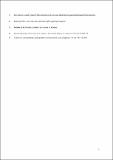Files in this item
How fast is a snail’s pace? : the influences of size and substrate on gastropod speed of locomotion
Item metadata
| dc.contributor.author | Pembury Smith, M. Q. R. | |
| dc.contributor.author | Ruxton, G. D. | |
| dc.date.accessioned | 2022-02-02T00:42:17Z | |
| dc.date.available | 2022-02-02T00:42:17Z | |
| dc.date.issued | 2021-05-01 | |
| dc.identifier | 272680716 | |
| dc.identifier | f33dcf43-0c86-4590-828c-a114ed05de67 | |
| dc.identifier | 85100318419 | |
| dc.identifier | 000613861000001 | |
| dc.identifier.citation | Pembury Smith , M Q R & Ruxton , G D 2021 , ' How fast is a snail’s pace? the influences of size and substrate on gastropod speed of locomotion ' , Journal of Zoology , vol. 314 , no. 1 , pp. 12-19 . https://doi.org/10.1111/jzo.12865 | en |
| dc.identifier.issn | 0952-8369 | |
| dc.identifier.other | Bibtex: https://doi.org/10.1111/jzo.12865 | |
| dc.identifier.other | ORCID: /0000-0001-8943-6609/work/88267533 | |
| dc.identifier.uri | https://hdl.handle.net/10023/24786 | |
| dc.description.abstract | Terrestrial gastropods display monotaxic direct crawling. During locomotion, smooth muscle contraction stimulates a series of pedal waves that move along the ventral surface of the foot. These waves interact with a thin layer of mucus produced by the foot, propelling the animal forward. Although the mechanism by which this process occurs has been well studied, less is known about how morphological or environmental factors affect this process, and ultimately how they may alter the speed of propulsion. In this study, we tested the influences of body size, substrate type, and substrate orientation on crawling speed in the terrestrial snail Cornu aspersum. We found that substrate texture and orientation had a strong effect on speed, whereas snail body size and the presence of a conspecific trail did not. Crawling speed across rough sandpaper was the most striking, showing a clear inversely proportional relationship between the size of abrasive particle and speed. We suggest that this may be the result of substrate attributes interfering with mucus adhesion or mucus production, subsequently affecting locomotion, although gait choice or the frequency and length of each pedal wave may also play a role. | |
| dc.format.extent | 8 | |
| dc.format.extent | 374113 | |
| dc.language.iso | eng | |
| dc.relation.ispartof | Journal of Zoology | en |
| dc.subject | Gastropod | en |
| dc.subject | Propulsion | en |
| dc.subject | Adhesive locomotion | en |
| dc.subject | Substrate | en |
| dc.subject | Size | en |
| dc.subject | QL Zoology | en |
| dc.subject | NDAS | en |
| dc.subject | MCC | en |
| dc.subject.lcc | QL | en |
| dc.title | How fast is a snail’s pace? : the influences of size and substrate on gastropod speed of locomotion | en |
| dc.type | Journal article | en |
| dc.contributor.institution | University of St Andrews. School of Biology | en |
| dc.contributor.institution | University of St Andrews. Centre for Biological Diversity | en |
| dc.identifier.doi | https://doi.org/10.1111/jzo.12865 | |
| dc.description.status | Peer reviewed | en |
| dc.date.embargoedUntil | 2022-02-02 |
This item appears in the following Collection(s)
Items in the St Andrews Research Repository are protected by copyright, with all rights reserved, unless otherwise indicated.

